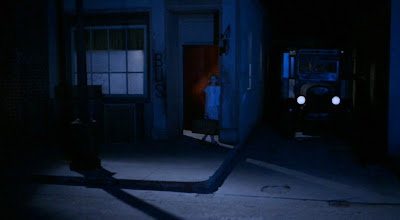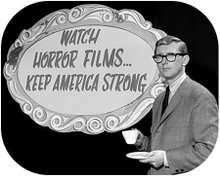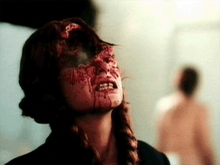Henri-Georges Clouzot, often referred to in English-speaking countries as "the French Alfred Hitchcock," was really the French Henri-Georges Clouzot, but the reductive comparison has some legitimacy. Both men made misanthropic but highly entertaining dark thrillers that were formally innovative and visually beautiful, and both men maintained a friendly rivalry in the 1950s and part of the 1960s. They greatly admired each other's films and shared similar obsessions. They also made each other nervous as competitors sharing the same thematic territory and talent. Hitchcock lived longer, started earlier, and created a more substantial body of work, but Clouzot was no slouch, directing such long-lasting classics as Quai des Orfevres, Wages of Fear, Le Corbeau, and Les Diaboliques.
Unlike famous control freak Hitchcock, Clouzot ultimately lost control of his own obsessions during the filming of 1964's unfinished L'Enfer. The film went drastically over-budget and over-schedule as Clouzot kept experimenting with color, black and white, different film stocks, multiple takes of the same scene, rewrites, narrative and avant-garde formal techniques, and color filters, and his obsession with lead Romy Schneider. Male lead Serge Reggiani walked off the movie months into filming, and a major heart attack Clouzot barely survived finally convinced the already terrified financiers to pull the plug on the film. Clouzot took a few years to recuperate, directing only a few television episodes and one much smaller-scale film before retiring from the movies in 1968. He died in 1977. The 2009 documentary, Henri-Georges Clouzot's Inferno, tells the story of the film's production but also spends half its running time showing completed scenes, screen tests, and unfinished footage from the never-finished film. Clouzot lost control of his movie, but what he managed to complete was stunningly beautiful and inventive. This documentary is amazing, and I recommend it to anyone who has ever tried to do anything creative, loves movies, or has a crush on Romy Schneider, which I think covers every living human with the exception of politicians and corporate executives.
Clouzot had a troubled final decade in the movie business, but the 1950s was his most productive and successful period, a decade in which he beat Hitchcock to the punch twice in three years, amping up the rivalry part of the friendly rivalry. Hitchcock attempted to purchase the rights to Georges Arnaud's novel Le Salaire de la Peur, but the writer wanted a French director to make the film, so Clouzot entered the picture, adapting it as Wages of Fear. (William Friedkin remade this film as Sorcerer in 1977, and it's an underrated classic and a rare remake that isn't garbage.) A few years later, Hitchcock went after the rights to another French novel, Celle qui n'etait plus by Pierre Boileau and Thomas Narcejac, but discovered he'd been scooped again by Clouzot. Clouzot filmed this novel as Les Diaboliques, or Diabolique in the U.S., and it made a huge impression on Hitchcock. The film's marketing stressed the importance of not ruining the twists for anyone who hadn't seen it, and Hitchcock used the same marketing gimmick for Psycho, a film he once described as his attempt to "out-Clouzot Clouzot." (Hitchcock adapted Boileau and Narcejac's D'Entre les Morts as Vertigo. The duo wrote the novel especially for Hitchcock to adapt after learning of his failure to acquire their earlier work.)
I am a man who usually thinks marketing can go make angry love to itself, but in these instances, I'm more sympathetic. Can you imagine how awesome it would be to watch Psycho knowing nothing about what's coming? Marion Crane's death would blow minds. Since Les Diaboliques is in French and since the American remake was such a huge flop, the twists are less well known in American pop culture, so I'm going to refrain from spoiling them here. I saw this film for the first time on the big screen at the Paramount Theatre in Austin during its summer classic film series, unaware of the twists, and it was a great experience. Watching it last night for a second time, I had a decidedly different experience. I enjoyed it just as much, but knowing the characters' actions and motives ahead of time made me look for things in the frame and notice shots, plot events, and elements of characterization I wouldn't have noticed that first go-round. It's almost like hearing the same story from two different people, with each person telling the story at a different pace, with different details, rhythms, and chronology.
Les Diaboliques, shot in sharp, beautiful, 1950s black and white, takes place at a small boarding school for boys shortly before, during, and after a school holiday. A wealthy but easily intimidated woman, Christina (Vera Clouzot), owns the school, teaches there, and is one of the two principals. She's a do-gooder, and the school was her longtime dream. The other principal is her husband, Michel (Paul Meurisse), a cruel, short-tempered, rotten son of a bitch who intimidates and bullies the school's small staff, students, wife, and mistress. The latter, Nicole (Simone Signoret), also teaches at the school. Her affair with Michel is common knowledge, even to Christina. Wife and mistress form an uneasy, unusual alliance based on a common goal: the murder of Michel. Despite her fragile, goody-goody exterior, Christina has a burning hatred for Michel that can't be satisfied by divorce. Her emotions trump her ethics and Catholicism. Nicole is a stronger, cooler, colder, more sophisticated woman who has little use for ethics. Michel has started roughing her up, and she's ready for some revenge.
The women travel to the town of Niort, where Nicole owns a home. An older couple rent the upstairs, Nicole occupies the downstairs. The plan is for Christina to call Michel and ask for a divorce. This tactic will enrage Michel enough for him to arrive in Niort. The women have spiked some wine with a strong sedative. Michel will drink it and pass out, the women will drown him in the bathtub, his body will be placed in a large wicker crate, the women will drive back to the school during the holiday and dump his body in the large murky swimming pool, his body will be discovered, the women will have the Niort alibi. Problem solved. You might imagine there will be complications. You will be right, but where those complications occur I will leave for you to discover.
Watching Les Diaboliques, I was continually reminded I was in the hands of a master. The black and white cinematography, the editing, the framing of shots, the performances, the storytelling pace, the tension and release of suspense, the tone, the atmosphere, the settings, all have a relaxed, natural feeling of effortlessness and continuity that can only be the result of tremendous talent, experience, work, and skill. In this era of short attention spans, CGI, and spatial incoherence, a film like Les Diaboliques only gets better with each viewing.
Saturday, November 24, 2012
Saturday, November 17, 2012
Flashback: Lemora: A Child's Tale of the Supernatural (Richard Blackburn, 1973)
I've already written about the next movie on the list, so I'll just reiterate that it's a beautiful, original, expressive film that is maybe one of my favorite horror films ever, is certainly one of the best horror films of the 1970s, and is well worth your time if your taste runs to the offbeat, poetic, and/or handmade corner of the horror film universe. Here's the link to my old review.
Sunday, November 11, 2012
#144: Laughing Dead (Patrick Gleason, 1998)
Laughing Dead does a lot with its very low budget and is so effective at setting up its dark tone that I can forgive its serious flaws. The film's first half is substantially better than its second half, the acting is amateurish and stilted, and the film never quite gels as a cohesive piece, but it has invention and atmosphere to burn. Writer/director/star Patrick Gleason doesn't have the budget to get all his ambitious ideas off the ground, but what a great first half.
The film opens with a man named Hunter (Gleason) washing up exhausted on a beach. He has little memory of who he is or where he came from. He does know that he's sick from withdrawal and needs a fix. He also quickly realizes that the world he's drifted into is, to quote many characters in the film, "fucked." This is a vaguely New York-ish post-apocalyptic wasteland, but it seems the apocalypse was gradual. There are fleeting references to past overpopulation and environmental disaster, but some infrastructure is left. The survivors live in shacks and dilapidated high-rises where they shoot up a heroin-like drug extracted from a black slug-like insect and watch the few channels still broadcasting on television. These consist of nightmarish images of horror, violence, and creepy clowns, laughtrack-heavy sitcoms, and live coverage of lottery winners presented with their winnings -- "tickets to paradise," Eddie Money not included.
The streets are not good places to hang out, and the people on the streets are in search of drugs, televisions, or prostitutes. A mutation in the population has caused some humans to turn into flesh-eating zombies, while others seem to have some sort of leprosy, limbs falling off and skin rotting away. White trucks comb the streets in search of people, and when they find them, "milkmen" carry them away to a mysterious gated compound. An ominous man in a limousine rides the streets, hitting some people for sport, and then returning to that same compound. Also, giant animals resembling rat/wild boar hybrids roam freely, inspiring my favorite line in the film: "Fuckin' street pigs, man." Also, vampires! Shit is, indeed, fucked.
Our protagonist finds himself sharing a shack with two vaguely lesbian women (many things in this film are vague), Joy (Nancy Rhee) and Lisa (Fern Finer). They ask him to get them some drugs and a television. He wanders the streets, collapses, and is sold by a male prostitute to a large, creepy man in a nice car. Following a street pig attack, Hunter is rescued by another man in a car, Phinneas (Rico Cymone), who gets him up to speed on all the ways shit is fucked after realizing the extent of Hunter's amnesia. Phinneas is an interesting character who is dropped from the film halfway through, for no good reason. The film seems to set him up as a revolutionary activist, battling the mysterious man in the limo and his strange compound, but never follows through on this storyline. Hunter finally gets his TV and brings it back to the women, but is soon brought into the orbit of the mystery limo man.
This first half of the film is exciting, creepy, and fun, and Gleason does a lot with very little money. The snippets of unsettling television programs, the street pig, the zombies, the bleak apocalyptic wasteland. All that stuff is awesome. The film's second half bogs down by leaving a lot of these elements and focusing on the relationship between Hunter and the limo man, Vincent (John Hammond). Hammond gives a wooden, hammy performance, and his incessant repetition of the phrase "little brother" quickly begins to grate. The exposition-heavy dialogue in this portion of the film does its actors no favors, though the final scene ends things on a high note.
Laughing Dead is Gleason's only feature film as a director and actor, which is too bad. He showed a lot of potential and is the strongest actor in the cast. I'd like to see what he could accomplish with more money and better actors. I hope he gets another chance, but the 14 years of silence since this film was released don't indicate we'll get another Gleason movie. To add insult to injury, Laughing Dead is hard to track down. I couldn't find it in any local video stores or on Netflix, so I purchased a used VHS copy online. A DVD has never been released in this country, though a UK DVD is available. As you can see from the stills illustrating this post, images from the film are hard to find online. Laughing Dead has a lot of problems common to ultra-low budget independent films, but it deserves better than that. There are some great things in it.
The film opens with a man named Hunter (Gleason) washing up exhausted on a beach. He has little memory of who he is or where he came from. He does know that he's sick from withdrawal and needs a fix. He also quickly realizes that the world he's drifted into is, to quote many characters in the film, "fucked." This is a vaguely New York-ish post-apocalyptic wasteland, but it seems the apocalypse was gradual. There are fleeting references to past overpopulation and environmental disaster, but some infrastructure is left. The survivors live in shacks and dilapidated high-rises where they shoot up a heroin-like drug extracted from a black slug-like insect and watch the few channels still broadcasting on television. These consist of nightmarish images of horror, violence, and creepy clowns, laughtrack-heavy sitcoms, and live coverage of lottery winners presented with their winnings -- "tickets to paradise," Eddie Money not included.
The streets are not good places to hang out, and the people on the streets are in search of drugs, televisions, or prostitutes. A mutation in the population has caused some humans to turn into flesh-eating zombies, while others seem to have some sort of leprosy, limbs falling off and skin rotting away. White trucks comb the streets in search of people, and when they find them, "milkmen" carry them away to a mysterious gated compound. An ominous man in a limousine rides the streets, hitting some people for sport, and then returning to that same compound. Also, giant animals resembling rat/wild boar hybrids roam freely, inspiring my favorite line in the film: "Fuckin' street pigs, man." Also, vampires! Shit is, indeed, fucked.
Our protagonist finds himself sharing a shack with two vaguely lesbian women (many things in this film are vague), Joy (Nancy Rhee) and Lisa (Fern Finer). They ask him to get them some drugs and a television. He wanders the streets, collapses, and is sold by a male prostitute to a large, creepy man in a nice car. Following a street pig attack, Hunter is rescued by another man in a car, Phinneas (Rico Cymone), who gets him up to speed on all the ways shit is fucked after realizing the extent of Hunter's amnesia. Phinneas is an interesting character who is dropped from the film halfway through, for no good reason. The film seems to set him up as a revolutionary activist, battling the mysterious man in the limo and his strange compound, but never follows through on this storyline. Hunter finally gets his TV and brings it back to the women, but is soon brought into the orbit of the mystery limo man.
This first half of the film is exciting, creepy, and fun, and Gleason does a lot with very little money. The snippets of unsettling television programs, the street pig, the zombies, the bleak apocalyptic wasteland. All that stuff is awesome. The film's second half bogs down by leaving a lot of these elements and focusing on the relationship between Hunter and the limo man, Vincent (John Hammond). Hammond gives a wooden, hammy performance, and his incessant repetition of the phrase "little brother" quickly begins to grate. The exposition-heavy dialogue in this portion of the film does its actors no favors, though the final scene ends things on a high note.
Laughing Dead is Gleason's only feature film as a director and actor, which is too bad. He showed a lot of potential and is the strongest actor in the cast. I'd like to see what he could accomplish with more money and better actors. I hope he gets another chance, but the 14 years of silence since this film was released don't indicate we'll get another Gleason movie. To add insult to injury, Laughing Dead is hard to track down. I couldn't find it in any local video stores or on Netflix, so I purchased a used VHS copy online. A DVD has never been released in this country, though a UK DVD is available. As you can see from the stills illustrating this post, images from the film are hard to find online. Laughing Dead has a lot of problems common to ultra-low budget independent films, but it deserves better than that. There are some great things in it.
Subscribe to:
Posts (Atom)















